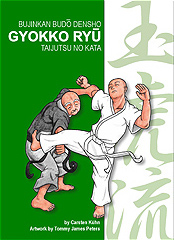Gyokko-Ryū
School of the Jeweled Tiger
The Gyokko-Ryū koshi jutsu is the oldest of the nine warrior traditions of the Bujinkan, and it can be said without question to be the core of most of our arts. Hatsumi Sensei established that koshi jutsu forms the basis for the following systems: Togakure-Ryū, Koto-Ryū, Gikan-Ryū, Shinden-fudo-Ryū, Gyokushin-Ryū, and Kumogakure-Ryū. Gyokko means bejeweled tiger
or tiger jewel and can refer to the tiger’s eye.
The method of movement and basic principles were developed in China during the Tang Dynasty (618-907). One suspects from the movements that it was developed by either a small man or a small woman. It is known that there was a woman at the court in Chan’an (now Xi’an) who was well known for her martial arts. When the Tang Dynasty was overthrown in 907, many of the nobles fled to Japan. The names Yo Gyokko (Yao Yu Hu) and Cho Gyokko are associated with the arrival of martial arts in Japan (perhaps they were the same person). General Ikai (or Ibou) is also associated with the origin of Gyokko Ryū. According to Hatsumi, this person could also be someone (bou) from a foreign country (I).
The first real sōke of the official Gyokko-Ryū was Tozawa Hakuunsai. His name may mean a connection with the Hakuun Ryū Ninjutsu, which no longer exists. This all took place in the Hogen Era (1156-1159), making Gyokko-Ryū the oldest documented fighting system in Japan.
Koshi jutsu means to knock down the tiger with one finger. That is why there is strong punching training, especially for the fingers, toes, and knuckles, but also for all other parts of the body. Characteristic of the fighting style is powerful blocks with the knuckles that destroy the attacker’s muscles, tearing and drilling techniques with fingers and toes, powerful stomping kicks, grappling techniques, and throws. In the Gyokko-Ryū it was taught to use only as much force as was necessary to defeat the opponent. In addition, the Ryū was known for his skills with the sword, for roku shaku bō and tantō.
The Nine Rules of Gyokko-Ryū
- The sign nin means to protect the nation, even with your life.
- Forget yourself. Be patient and do not fear death.
- In dangerous situations, say nothing and show nothing.
- When a strong enemy appears, keep an indomitable spirit.
- Serve and protect the master, just like your parents.
- Crime dissipates your skills.
- Drunkenness impairs your judgment.
- Destroy the opponent’s power, but leave him his life.
- Do not teach others without Master’s permission.
Sōke of the Gyokko-Ryū
- Tozawa Hakuunsai
- Tozawa Shozuke
- Suzuki Saburo Shigeyoshi
- Suzuki Gobei
- Suzuki Kojiro Mitsu
- Tozawa Nyudo Geneai
- Yamon Hyoun
- Kato Ryu Hakuun
- Sakagami Goro Katsushige
- Sakagami Taro Kunishige
- Sakagami Kotaro Masahide
- Sougyoko Kan Ritsushi
- Toda Sakyo Ishinsai
- Momochi Sandayu I
- Momochi Sandayu II
- Momochi Tanba Yasumitsu
- Momochi Taro Saemon
- Toda Seiryu Nobutsuna
- Toda Fudo Nobuchika
- Toda Kangoro Nobuyasu
- Toda Eisaburo Nobumasa
- Toda Shinbei Masachika
- Toda Shingoro Masayoshi
- Toda Daigoro Chikashige
- Toda Daisaburo Chikashige
- Toda Shinryuken Masamitsu
- Takamatsu Toshitsugu
- Hatsumi Masaaki
